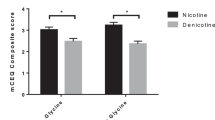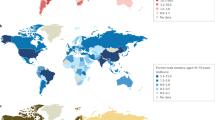Abstract
The dopamine receptor D2 (DRD2) gene has polymorphisms that have been linked to regulation of the dopamine system and to an increased prevalence of smoking. The present study examined the relationship of the DRD2 TaqI-A and -B polymorphisms with short-term clinical outcome (abstinence and withdrawal symptoms), collected from daily (14 pre-quit and 42 post-quit) diary data among smokers (n=116) treated with the nicotine patch plus either venlafaxine or placebo. The results showed that B1/B1 or B1/B2 smokers were slightly less likely to be abstinent on a given day than those homozygous for the TaqI-B2 allele. Significant DRD2 TaqI-B × time interactions were found for several of the withdrawal scales, indicating that those smokers with the B1/B1 or B1/B2 genotypes tended to report more symptoms over time compared to those with the B2/B2 genotype. No interactions or main effects were found for the DRD2 TaqI-A polymorphism. The findings demonstrate that smokers homozygous for the TaqI-B2 allele experience progressive improvement in self-reported withdrawal symptoms while smokers with the TaqI-B1 allele showing little change.
This is a preview of subscription content, access via your institution
Access options
Subscribe to this journal
Receive 6 print issues and online access
$259.00 per year
only $43.17 per issue
Buy this article
- Purchase on Springer Link
- Instant access to full article PDF
Prices may be subject to local taxes which are calculated during checkout


Similar content being viewed by others
References
Wise RA, Rompre PP . Brain dopamine and reward. Ann Rev Psychol 1989; 40: 191–225.
Blum K, Noble EP, Sheridan PJ, Finley O, Montgomery A, Ritchie T et al. Association of the A1 allele of the D2 dopamine receptor gene with severe alcoholism. Alcohol 1991; 8: 409–416.
Comings DE, Comings BG, Muhlemann D . The dopamine D2 receptor locus as a modifying gene in neuropsychiatric disorders. JAMA 1991; 266: 1793–1800.
O'Hara BF, Smith SS, Bird G, Persico AM, Suarez BK, Cutting GR et al. Dopamine D2 receptor RFLPs, haplotypes, and their association with substance use in Black and Caucasian research volunteers. Hum Hered 1993; 43: 209–218.
Hauge XY, Grandy DK, Eubanks JH, Evans GA, Civelli O, Litt M . Detection and characterization of additional DNA polymorphisms in the dopamine D2 receptor gene. Genomics 1991; 10: 527–530.
Neville MJ, Johnstone EC, Walton RT . Identification and characterization of ANKK1: A novel kinase gene closely linked to DRD2 on chromosome band 11q23.1. Hum Mutat 2004; 23: 540–545.
Duan J, Wainwright MS, Comeron JM, Saitou N, Sanders AR, Gelernter J et al. Synonymous mutations in the human dopamine receptor D2 (DRD2) affect mRNA stability and synthesis of the receptor. Hum Mol Genet 2003; 12: 205–216.
Arinami T, Gao M, Hamaguchi H, Toru M . A functional polymorphism in the promoter region of the dopamine D2 receptor gene is associated with schizophrenia. Hum Mol Genet 1997; 6: 577–582.
Noble EP, Blum K, Ritchie T, Montgomery A, Sheridan PJ . Allelic association of the D2 dopamine receptor gene with receptor-binding characteristics in alcoholism. Arch Gen Psychiatry 1991; 48: 648–654.
Jonsson EG, Nothen MM, Grunhage F, Farde L, Nakashima Y, Propping P et al. Polymorphisms in the dopamine D2 receptor gene and their relationships to striatal dopamine receptor density of healthy volunteers. Mol Psychiatry 1999; 4: 290–296.
Pohjalainen T, Rinne JO, Nagren K, Lehikoinen P, Anttila K, Syvalahti EK et al. The A1 allele of the human D2 dopamine receptor gene predicts low D2 receptor availability in healthy volunteers. Mol Psychiatry 1998; 3: 256–260.
Munafo M, Clark T, Johnstone E, Murphy M, Walton R . The genetic basis for smoking behavior: a systematic review and meta-analysis. Nicotine Tob Res 2004; 6: 583–597.
Li MD, Ma JZ, Beuten J . Progress in searching for susceptibility loci and genes for smoking-related behaviour. Clin Genet 2004; 66: 382–392.
Comings DE, Ferry L, Bradshaw-Robinson S, Burchette R, Chiu C, Muhleman D . The dopamine D2 receptor (DRD2) gene: a genetic risk factor in smoking. Pharmacogenetics 1996; 6: 73–79.
Noble EP, St Jeor ST, Ritchie T, Syndulko RT, St Jeor SC, Fitch RJ et al. D2 dopamine receptor gene and cigarette smoking: A reward gene? Med Hypotheses 1994; 42: 257–260.
Spitz MR, Shi H, Hudmon KS, Jiang H, Chamberlain RM, Amos CI et al. A case–control study of the dopamine D2 receptor gene and smoking status in lung cancer. J Natl Cancer Inst 1998; 90: 358–363.
Pastorelli R, Bardazzi G, Saieva C, Cerri A, Gestri D, Allamani A et al. Genetic determinants of alcohol addiction and metabolism: a survey in Italy. Alcohol Clin Exp Res 2001; 25: 221–227.
Wu X, Hudmon KS, Detry MA, Chamberlain RM, Spitz MR . D2 dopamine receptor gene polymorphisms among African-Americans and Mexican-Americans: a lung cancer case-control study. Cancer Epidemiol Biomarker Prevent 2000; 9: 1021–1026.
Bierut LJ, Rice JP, Edenberg HJ, Goate A, Foroud T, Cloninger CR et al. Family-based study of the association of the dopamine D2 receptor gene (DRD2) with habitual smoking. Am J Med Genet 2000; 90: 299–302.
Anokhin AP, Todorov AA, Madden PA, Grant JD, Heath AC . Brain event-related potentials, dopamine D2 receptor gene polymorphism, and smoking. Genet Epidemiol 1999; 17(Suppl 1): S37–S42.
Gilbert DG, McClernon FJ, Rabinovich NE, Sugai C, Plath LC, Asgaard G et al. Effects of quitting smoking on EEG activation and attention last for more than 31 days and are more severe with stress, dependence, DRD2 A1 allele, and depressive traits. Nicotine Tob Res 2004; 6: 249–267.
Piasecki TM, Fiore MC, Baker TB . Profiles in discouragement: two studies of variability in the time course of smoking withdrawal symptoms. J Abnorm Psychol 1998; 107: 238–251.
Piasecki TM, Niaura R, Shadel WG, Abrams DB, Goldstein M, Fiore MC et al. Smoking withdrawal dynamics in unaided quitters. J Abnorm Psychol 2000; 109: 74–86.
Piasecki TM, Jorenby DE, Smith SS, Fiore MC, Baker TB . Smoking withdrawal dynamics: I. Abstinence distress in lapsers and abstainers. J Abnorm Psychol 2003; 112: 3–13.
Prochaska JO, Velicer WF, Diclemente CC, Guadagnoli E, Rossi JS . Patterns of change: dynamic typology applied to smoking cessation. Multivar Behav Res 1991; 26: 83–107.
Shiffman S, Paty J, Gnys M, Kassel J, Hickcox M . First lapses to smoking: within-subjects analysis of real-time reports. J Consul Clin Psychol 1996; 64: 366–379.
Cinciripini PM, Wetter DW, Tomlinson GE, Tsoh JY, De Moor CA, Cinciripini LG et al. The effects of the DRD2 polymorphism on smoking cessation and negative affect: evidence for a pharmacogenetic effect on mood. Nicotine Tob Res 2004; 6: 229–239.
Shiffman S, West R, Gilbert D . Recommendation for the assessment of tobacco craving and withdrawal in smoking cessation trials. Nicotine Tob Res 2004; 6: 599–614.
Piasecki TM, Jorenby DE, Smith SS, Fiore MC, Baker TB . Smoking withdrawal dynamics: II. Improved tests of withdrawal-relapse relations. J Abnorm Psychol 2003; 112: 14–27.
Piasecki TM, Jorenby DE, Smith SS, Fiore MC, Baker TB . Smoking withdrawal dynamics: III. Correlates of withdrawal heterogeneity. Exp Clin Psychopharmacol 2003; 11: 276–285.
Watson D, Clark LA, Tellegen A . Development and validation of brief measures of positive and negative affect: the PANAS Scales. J Personal Soc Psychol 1988; 54: 1063–1070.
Welsch SK, Smith SS, Wetter DW, Jorenby DE, Fiore MC, Baker TB . Development and validation of the Wisconsin smoking withdrawal scale. Exp Clin Psychopharmacol 1999; 7: 354–361.
Cinciripini PM, Tsoh JT, Wetter DW, Lam CY, De Moor CA, Cinciripini LG et al. Combined effects of venlafaxine, nicotine replacement & brief counseling on smoking cessation. Exp Clin Psychopharmacol 2005; 13: 282–292.
Cinciripini PM, Cinciripini LG, Seay S, Wallfisch A, Myer WJ, Van Vunakis H . A placebo-controlled evaluation of the effects of buspirone on smoking cessation: Differences between high and low anxiety smokers. J Clin Psychopharmacol 1995; 15: 182–191.
Cinciripini PM, Cinciripini LG, Wallfisch A, Van Vunakis H, Haque W . Behavior therapy and the transdermal nicotine patch: Effects on cessation outcome, affect, and coping. J Consul Clin Psychol 1996; 64: 314–323.
Fiore MC, Bailey WC, Cohen SJ, Dorfman SF, Goldstein MG, Gritz ER et al. Treating Tobacco Use and Dependence. Clinical Practice Guideline. US Department of Health and Human Services: Rockville, MD, 2000.
First MB, Spitzer RL, Gibbon M, Williams JB . Structured Clinical Interview for Axis I DSM-IV Disorders, Patient Edition (SCID-II, version 2.0). Biometrics Research Department, New York State Psychiatric Institute: New York, 1994.
Heatherton TF, Kozlowski LT, Frecker RC, Fagerström KO . The Fagerström test for nicotine dependence: a revision of the Fagerström Tolerance Questionnaire. Br J Addict 1991; 86: 1119–1127.
Hughes JR, Hatsukami D . Signs and symptoms of tobacco withdrawal. Arch Gen Psychiatry 1986; 43: 289–294.
McCullagh P, Nedler JA . Generalized Linear Models. 2nd edn, Whapman & Hall: NY, New York, 1989.
Gibbons R, Hedeker D, Waternaux C . Random regression models: a comprehensive approach to the analysis of longitudinal psychiatric data. Psychopharmacology 1988; 24: 438–443.
Gibbons R, Hedeker D, Elkin I, Waternaux C, Kraemer KH, Greehouse J et al. Some conceptual and statistical issues in the analysis of longitudinal psychiatric data. Arch Gen Psychiatry 1993; 50: 739–750.
Wright SP . Multivariate Analysis Using the MIXED Procedure. Proceedings of the 23rd Annual SAS Users Group International Conference, Paper 229. SAS Institute Inc.: Cary, NC, 1998.
Acknowledgements
Support for this research was provided by grants from the MD Anderson Cancer Center (PRS), the National Cancer Institute (SPORE P50CA70907), and the National Institute on Drug Abuse (R01DA1182-01) to Paul M Cinciripini and MD Anderson Education Program in Cancer Prevention Postdoctoral Fellowship Grants (R25 CA57730) to Jason D Robinson, Cho Y Lam and Jennifer A Minnix. Study medication and nicotine patches were provided by Wyeth-Ayerst Laboratories. Portions of this research were presented at the annual meeting of the Society for Research on Nicotine and Tobacco, Orlando, Florida, February 2006.
Author information
Authors and Affiliations
Corresponding author
Additional information
Duality of Interest
None declared.
Rights and permissions
About this article
Cite this article
Robinson, J., Lam, C., Minnix, J. et al. The DRD2 TaqI-B polymorphism and its relationship to smoking abstinence and withdrawal symptoms. Pharmacogenomics J 7, 266–274 (2007). https://doi.org/10.1038/sj.tpj.6500427
Received:
Revised:
Accepted:
Published:
Issue Date:
DOI: https://doi.org/10.1038/sj.tpj.6500427
Keywords
This article is cited by
-
The dopamine D2 receptor mediates approach-avoidance tendencies in smokers
European Archives of Psychiatry and Clinical Neuroscience (2018)
-
Relationship among methadone dose, polymorphisms of dopamine D2 receptor and tri-dimensional personality questionnaire in heroin-addicted patients
Behavioral and Brain Functions (2016)
-
NCAM1-TTC12-ANKK1-DRD2 variants and smoking motives as intermediate phenotypes for nicotine dependence
Psychopharmacology (2015)
-
The Aggregate Effect of Dopamine Genes on Dependence Symptoms Among Cocaine Users: Cross-Validation of a Candidate System Scoring Approach
Behavior Genetics (2012)
-
Common and Unique Biological Pathways Associated with Smoking Initiation/Progression, Nicotine Dependence, and Smoking Cessation
Neuropsychopharmacology (2010)



